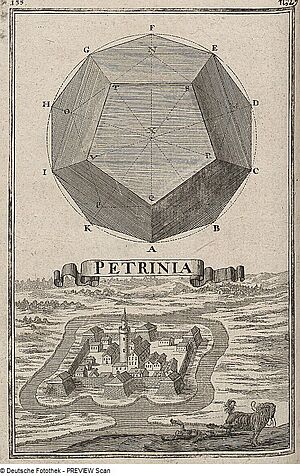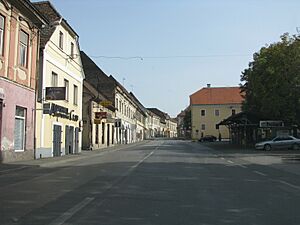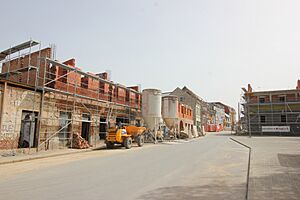Petrinja facts for kids
Quick facts for kids
Petrinja
|
|
|---|---|
| Grad Petrinja Town of Petrinja |
|
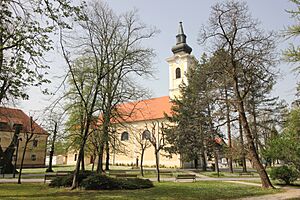
Park and St. Lawrence church in Petrinja
|
|
| Country | |
| Region | Continental Croatia (Banovina) |
| County | |
| Area | |
| • Town | 379.3 km2 (146.4 sq mi) |
| • Urban | 39.4 km2 (15.2 sq mi) |
| Elevation | 106 m (348 ft) |
| Population
(2021)
|
|
| • Town | 19,950 |
| • Density | 52.597/km2 (136.23/sq mi) |
| • Urban | 12,963 |
| • Urban density | 329.0/km2 (852.1/sq mi) |
| Time zone | UTC+1 (CET) |
| • Summer (DST) | UTC+2 (CEST) |
| Postal code |
44 250
|
| Area code(s) | 044 |
| Vehicle registration | SK |
Petrinja is a town in central Croatia. It is located near Sisak in the historic area of Banovina. The town is part of Sisak-Moslavina County.
On December 29, 2020, a strong earthquake hit Petrinja. It had a magnitude of 6.4 Mw. This earthquake caused a lot of damage to the town.
Contents
What's in a Name?
The name Petrinja might come from the Greek word pétra. This word means "stone". It could also come from the Latin word petrus.
Another idea is that Petrinja was named after a church. This church was dedicated to St. Peter. It was from the time of the Diocese of Sisak. People say the town existed in Roman times. It was in an area called Zrinska Gora, which has a lot of stone.
A Look Back: Petrinja's History
Early Times: The Middle Ages
West of Petrinja is Petrova gora, or Peter's mountain. A famous battle happened here in 1097. It was the Battle of Gvozd Mountain. King Petar Snačić of Croatia fought against Coloman from Hungary.
The first time Petrinja was written about was in 1240. The duke of Slavonia, Koloman, gave special benefits to the people living there. This old medieval Petrinja was a place of fighting with the Ottoman Empire.
16th and 17th Centuries: Fortresses and Freedom
The old fortress in Petrinja was destroyed in 1543. This was done to stop the Ottomans from taking it over. In 1592, a new Ottoman fortress was built in a different spot. It was at the meeting point of the Petrinjčica and Kupa rivers. This fortress was meant to help the Ottomans attack central Croatia. One such attack was the 1593 battle of Sisak.
On August 10, 1594, the Croatian army freed the fortress. Because of this, August 10 is a special day for the town. It is a day to thank God and St. Lawrence. St. Lawrence became the patron saint of Petrinja. Over time, many craftspeople and merchants came to Petrinja. Their arrival helped the town grow and develop.
In 1773, Empress Maria Theresa of Austria made an important decision. She decided that Petrinja would be a center for craft guilds. This was for the whole area of the Military Frontier.
18th and 19th Centuries: Growth and Revival
Petrinja was part of Napoleon's Illyria from 1809 to 1813. During this time, the town became an important place for trade and travel. The French army also planted the linden trees that you can still see today.
In the 19th century, the Croatian national revival movement had an impact on Petrinja. Many important groups and institutions were started then. These included the Town Orchestra (1808) and the Music Department (1841). A Library and reading-room opened in 1842. The Teachers' Training School started in 1862. The Croatian Choir "Slavulj" was founded in 1864. The Town fire-brigade began in 1880, and the First printing-house in 1881.
In the late 1800s and early 1900s, Petrinja was a district capital. It was in the Zagreb County of the Kingdom of Croatia-Slavonia.
20th and 21st Centuries: Challenges and Rebuilding
From 1929 to 1939, Petrinja was part of the Sava Banovina. Then, from 1939 to 1941, it was part of the Banovina of Croatia. This was all within the Kingdom of Yugoslavia.
During World War II, Petrinja faced difficult times. Many people were treated unfairly. There was also fighting between different groups.
More recently, the town experienced the war in Croatia. Many people had to leave their homes between 1991 and 1995. The town itself was badly damaged. After the war, many monuments were put up. These remember Croatian war heroes and those who suffered.
When rebuilding, the people of Petrinja worked hard to keep their town's traditions alive. They celebrate Catholic holidays and hold many cultural, social, and sports events.
On December 29, 2020, a powerful earthquake hit the town. It had a magnitude of 6.4 Mw. Seven people died, including a seven-year-old girl. Half of the town was destroyed. At least 20 people were hurt. Many smaller tremors continued for days after the main quake.
Petrinja's Economy
The economy of Petrinja has faced challenges in recent years. The effects of the war from the 1990s are still felt. Many villages are less populated, and farms have closed. These farms used to supply local businesses.
The biggest company and employer in Petrinja is Gavrilović. It is a meat packing plant. It currently employs about 800 people.
Other important industries include sawmills and wood flooring factories. A former furniture factory is now mostly empty. However, there are plans to use part of it for making hardwood flooring. A brick factory has been turned into a large sawmill called Nil-Ž. It employs over 100 people.
Small businesses are still developing in Petrinja. The city has plans to open a special zone for small businesses. However, there haven't been many visible results yet.
Many small family farms, called O.P.G., have been started. But only a few produce large amounts of food. They offer fresh meat, fruits, vegetables, flowers, and herbs. It can be hard for these small farmers to compete with larger producers.
The city used to have a local transportation company called Slavijatrans. It ran bus lines and cargo trucks. Now, a larger national company, Čazmatrans, owns it. It only operates local passenger bus lines.
Here are some of the notable businesses in Petrinja:
- Gavrilović d.o.o. (meat packing)
- Nil-Ž (sawmill)
- Finel (furniture and flooring manufacturing)
- TSH (animal feed factory)
- Slavijatrans (now Čazmatrans) (transportation, public transit)
- Rotomat (specialty rotary sanding discs manufacturing)
- Pekarne EDI (bakery chain)
Traditional Crafts and Food
After the Ottomans left in the late 1500s, Petrinja became a hub for craftspeople and merchants. They helped the town grow. There is a strong tradition of pottery and ceramic crafts here. These crafts produce unique souvenirs for the area. They are made from high-quality clay. A famous souvenir is the "stucka." It is a decorated clay jar used for many things. It has become a symbol of Petrinja.
The first Croatian salami, cured meat, and lard factory started in 1792. This factory grew into the "Gavrilović" factory. It is a major part of the area's economy. It is well-known for its high-quality food products.
Important Landmarks
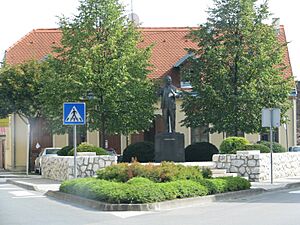
The first Catholic parish Church of St. Lawrence was built in 1603. Because of its age, a new church was built in 1781. It was built in a beautiful late baroque and classicist style.
A statue of Croatian politician Stjepan Radić was made in Petrinja in 1929. This was after he was assassinated. In 1936, the statue was placed in the town's main square, which was named after him. In 1963, the statue was moved to a city park. In 1991, it was damaged and moved to a nearby village. It was found in 1998 and then repaired. In 1999, it was returned to Petrinja's central square. The Croatian minister of culture, Božo Biškupić, unveiled it.
Petrinja's Population
| Historical population | ||
|---|---|---|
| Year | Pop. | ±% |
| 1869 | 20,403 | — |
| 1880 | 21,091 | +3.4% |
| 1890 | 24,958 | +18.3% |
| 1900 | 27,873 | +11.7% |
| 1910 | 29,633 | +6.3% |
| 1921 | 28,383 | −4.2% |
| 1931 | 29,808 | +5.0% |
| 1948 | 24,293 | −18.5% |
| 1953 | 25,070 | +3.2% |
| 1961 | 27,517 | +9.8% |
| 1981 | 33,570 | +22.0% |
| 1991 | 35,565 | +5.9% |
| 2001 | 23,413 | −34.2% |
| 2011 | 24,671 | +5.4% |
| Source: Naselja i stanovništvo Republike Hrvatske 1857–2001, DZS, Zagreb, 2005 & Popis stanovništva 2011 | ||
In 2011, Petrinja had a total population of 24,671 people. About 15,683 of them lived in the main town area.
The town area includes these settlements (with their 2011 populations):
- Begovići, population 58
- Bijelnik, population 47
- Blinja, population 78
- Brest Pokupski, population 279
- Cepeliš, population 59
- Čuntić, population 27
- Deanovići, population 28
- Dodoši, population 76
- Donja Bačuga, population 142
- Donja Budičina, population 236
- Donja Mlinoga, population 96
- Donja Pastuša, population 11
- Donje Mokrice, population 57
- Dragotinci, population 63
- Dumače, population 272
- Glinska Poljana, population 121
- Gora, population 264
- Gornja Bačuga, population 79
- Gornja Mlinoga, population 33
- Gornja Pastuša, population 31
- Gornje Mokrice, population 105
- Graberje, population 155
- Grabovac Banski, population 200
- Hrastovica, population 464
- Hrvatski Čuntić, population 86
- Jabukovac, population 141
- Jošavica, population 84
- Klinac, population 27
- Kraljevčani, population 63
- Križ Hrastovički, population 141
- Luščani, population 163
- Mačkovo Selo, population 36
- Mala Gorica, population 510
- Međurače, population 36
- Miočinovići, population 43
- Mošćenica, population 2,470
- Moštanica, population 93
- Nebojan, population 191
- Nova Drenčina, population 402
- Novi Farkašić, population 81
- Novo Selište, population 321
- Pecki, population 84
- Petkovac, population 15
- Petrinja, population 15,683
- Prnjavor Čuntićki, population 79
- Sibić, population 67
- Slana, population 92
- Srednje Mokrice, population 33
- Strašnik, population 202
- Stražbenica, population 9
- Taborište, population 227
- Tremušnjak, population 47
- Veliki Šušnjar, population 117
- Vratečko, population 60
- Župić, population 85
| population |
18448
|
20403
|
21091
|
24958
|
27873
|
29633
|
28383
|
29808
|
24293
|
25070
|
27465
|
30545
|
33124
|
35151
|
23413
|
24671
|
19950
|
| 1857 | 1869 | 1880 | 1890 | 1900 | 1910 | 1921 | 1931 | 1948 | 1953 | 1961 | 1971 | 1981 | 1991 | 2001 | 2011 | 2021 |
| Population by ethnicity | ||||
|---|---|---|---|---|
| Year of census | total | Croats | Serbs | others |
| 1961 | 27,517 | 14,942 (54.30%) | 11,955 (43.45%) | 620 (2.25%) |
| 1981 | 33,570 | 14,621 (43.55%) | 12,617(37.58%) | 6,332 (18.86%) |
| 1991 | 35,565 | 15,791 (44.40%) | 15,969 (44.90%) | 3,805 (10.70%) |
| 2001 | 23,413 | 19,280 (82.35%) | 2,809 (12.00%) | 1,324 (5.65%) |
| 2011 | 24,671 | 20,925 (84.82%) | 2,710 (10.98%) | 1,036 (4.20%) |
Famous People from Petrinja
Here is a list of some well-known people who are from Petrinja:
- Franjo Jelačić (1746–1810), an officer from the House of Jelačić
- Stevan Šupljikac (1786–1848), a military leader and duke
- Janko Grahor (1827–1906), an architect
- Emil Vojnović (1851–1927), an Austro-Hungarian Army general
- Oton Kučera (1856–1931), an astronomer
- Krsto Hegedušić (1901–1975), an artist
- Branko Horvat (1928–2003), an economist and politician
- Milan Nenadić (1943–), a Greco-Roman wrestler
- Drago Roksandić (1948-), a historian
- Marijan Vlak (1955–), a former football goalkeeper
- Vlado Lisjak (1962–), a Greco-Roman wrestler
- Aleksandar Jovančević (1970–), a Greco-Roman wrestler
See also
 In Spanish: Petrinja para niños
In Spanish: Petrinja para niños



